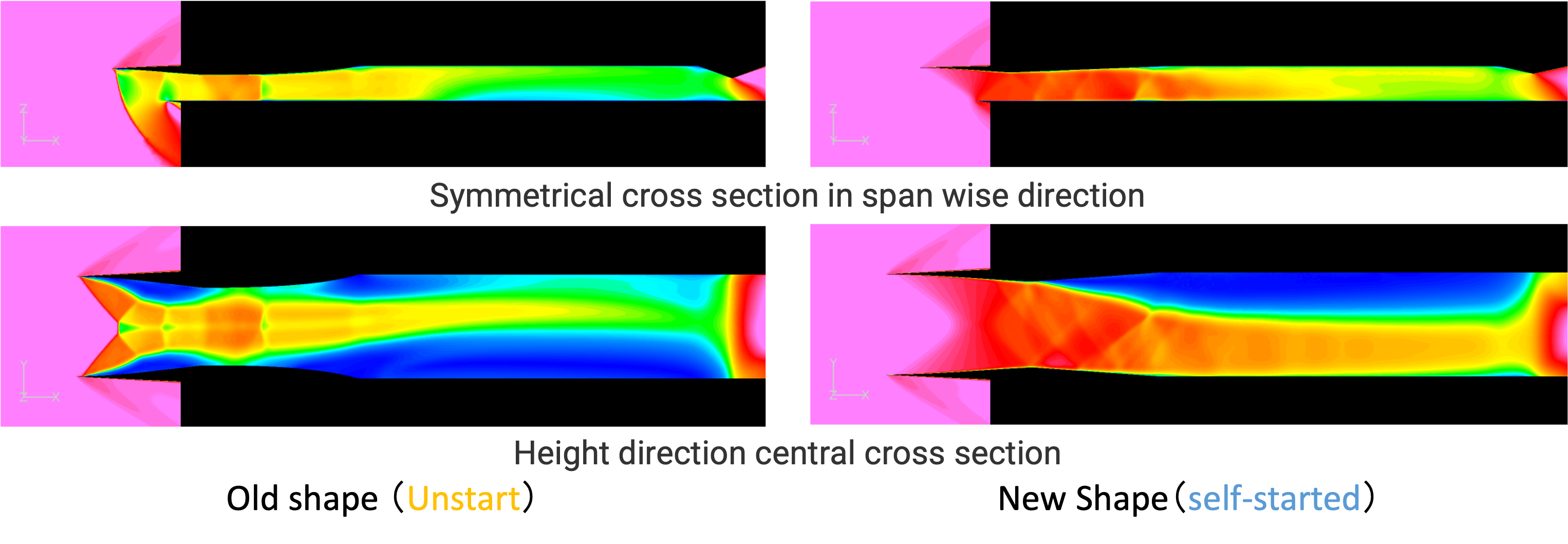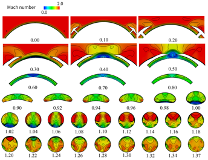Verification Research of Atmosphere-assisted Flight in Reusable Space Transportation System
JAXA Supercomputer System Annual Report February 2024-January 2025
Report Number: R24EDU10308
Subject Category: Space and Astronautical Science
- Responsible Representative: Yusuke Maru, Associate Professor, Institute of Space and Astronautical Science
- Contact Information: Yusuke Maru(maru.yusuke@jaxa.jp)
- Members: Yusuke Maru, Tasuku Miyazaki, Shingo Matsuyama, Yuma Miki, Takumi Ohno, Daiki Watanabe, Tsubasa Watabe
Abstract
We are conducting technological research necessary to realize a space transportation system that actively and effectively utilizes the Earth's atmosphere. Specifically, we are conducting design research on air intakes for air-breathing engines.
Reference URL
N/A
Reasons and benefits of using JAXA Supercomputer System
AXA's analysis tools (FaSTAR, CHARIOT) are being run on the JSS to clarify the intake flow field. FaSTAR is being used for flow path design research under a variety of different conditions, while CHARIOT is being used to carefully clarify the physical phenomena in the flow field. Both of these require large-scale calculations, making the use of supercomputers essential.
Achievements of the Year
(1) Using the Busemann method, the boundary layer thickness was estimated based on an axisymmetric boundary layer integral equation for the theoretically derived shape, and a correction was made accordingly. The effect of this correction on intake starting performance was verified using FaSTAR. In addition, the shape of the subsonic diffuser downstream of the throat was designed by trial and error using FaSTAR (Fig. 1).
(2) In order to mount the Busemann intake on an axisymmetric rocket, we designed a Busemann intake with an arched cross section and evaluated the flow field characteristics when the intake was mounted on the vehicle (Fig. 2).
(3) When comparing the pressure distribution of the flow analysis under wind tunnel test conditions using FaSTAR with the wind tunnel test results, the overall trends were reproduced well, but there was a large qualitative and quantitative discrepancy, especially in the pressure distribution near the intake inlet. To investigate the cause of this, a higher-fidelity LES analysis was performed using CHARIOT. (Fig.3)
Publications
- Oral Presentations
1) Yuma Miki, Tasuku Miyazaki, Kiyoshi Kinefuchi, Yusuke Maru, Hiroaki Kobayashi, Shinichiro Tokudome and Tetsuya Sato, "Mass Capture Ratio Evaluation of Supersonic Busemann Intake for ATRIUM Combined Cycle Engine," 16th International Space Conference of Pacific-basin Societies (ISCOPS), Obihiro, Japan, November 2024.
2) Yusuke Maru, Tetsuya Sato, Katsuyoshi Fukiba, Kiyoshi Kinefuchi, Shingo Matsuyama, Study of Three-dimensional Air Inlet Ingesting Boundary Layer for Vertical Take-off and Landing Reusable Rocket, 16th International Space Conference of Pacific-basin Societies (ISCOPS), Obihiro, Japan, November 2024.
3) Yusuke MARU, Kazuma MATSUMOTO, Daiki WATANABE, Tetsuya SATO, A three-dimensional streamline-traced air inlet for the reusable sounding rocket with the air turbo rocket engine, 26th ISABE conference, ISABE-2024-125, October 2024, Toulouse.
Usage of JSS
Computational Information
- Process Parallelization Methods: MPI
- Thread Parallelization Methods: OpenMP
- Number of Processes: 256
- Elapsed Time per Case: 8.3 Hour(s)
JSS3 Resources Used
Fraction of Usage in Total Resources*1(%): 0.13
Details
Please refer to System Configuration of JSS3 for the system configuration and major specifications of JSS3.
| System Name | CPU Resources Used(Core x Hours) | Fraction of Usage*2(%) |
|---|---|---|
| TOKI-SORA | 3160886.56 | 0.14 |
| TOKI-ST | 9063.50 | 0.01 |
| TOKI-GP | 0.00 | 0.00 |
| TOKI-XM | 0.00 | 0.00 |
| TOKI-LM | 114.88 | 0.01 |
| TOKI-TST | 2592.02 | 0.05 |
| TOKI-TGP | 0.00 | 0.00 |
| TOKI-TLM | 0.00 | 0.00 |
| File System Name | Storage Assigned(GiB) | Fraction of Usage*2(%) |
|---|---|---|
| /home | 1538.50 | 1.04 |
| /data and /data2 | 134551.00 | 0.64 |
| /ssd | 30971.00 | 1.66 |
| Archiver Name | Storage Used(TiB) | Fraction of Usage*2(%) |
|---|---|---|
| J-SPACE | 2.76 | 0.01 |
*1: Fraction of Usage in Total Resources: Weighted average of three resource types (Computing, File System, and Archiver).
*2: Fraction of Usage:Percentage of usage relative to each resource used in one year.
ISV Software Licenses Used
| ISV Software Licenses Used(Hours) | Fraction of Usage*2(%) | |
|---|---|---|
| ISV Software Licenses(Total) | 197.45 | 0.13 |
*2: Fraction of Usage:Percentage of usage relative to each resource used in one year.
JAXA Supercomputer System Annual Report February 2024-January 2025





